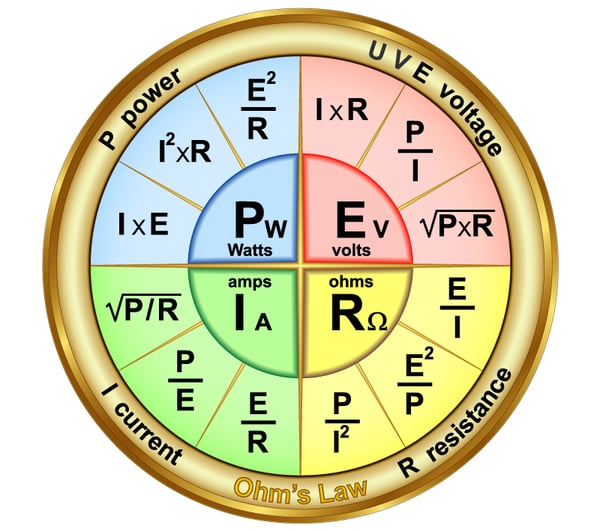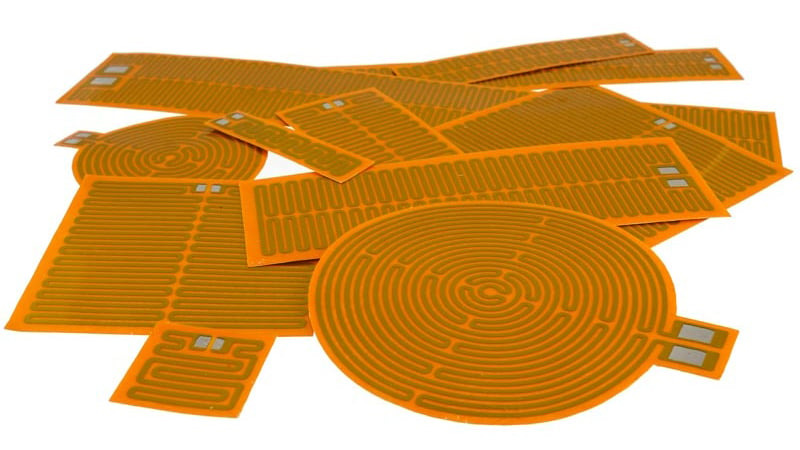When talking about flexible heaters, determining the amount of efficient heat necessary for the application is required. A range of factors impacts generated electrical heat, including the materials that are used, the wattage, the voltage, the size of the heater, and the pattern of the conducive materials within the heater. One of the vital factors in designing a flexible heater revolves around Ohm's Law.
What is Ohm's Law?
Ohm's law is a formula that is used to determine the relationship between wattage, voltage, amperage, and resistance. In layman's terms, Ohm's Law signifies the amount of current that is passing through an electrical circuit's conductor as it is proportional to the voltage across it. The formula for Ohm's Law involves the current (I) is equal to the voltage (V) divided by the resistance (R).
- I = V / R (current = voltage / resistance)
For flexible heaters, the same Ohm's Law applies. You are determining the strength of the current by amperages based on the operating power of the flexible heater in watt units (wattage) divided by voltage. So, the formula would look like:
- A = W / V (amperage = wattage / voltage)
Ohm's Law is necessary in the design of flexible heaters to figure out how much resistance will be created, as resistance is measured in ohms. Resistance in electrical circuits will transform the electrical energy that passes through it into the required heat as this is indicated by the watt density. While customers typically want lower resistance in other electrical and electronic equipment to minimize heat that can damage printed circuit boards, circuitry and other components, flexible heaters seek a higher level of resistance to create the necessary heat that will pass through materials and into the application.

Ohm's law is a formula that is used to determine the relationship between wattage, voltage, amperage, and resistance.
Materials Contribute to Applied Efficiency and Temperature
Flexible heaters are typically made from silicon rubber or polyimide materials. These materials are flexible enough to be bent and shaped around applications to apply heat in the specific place. Based on the type of materials used, they will be able to withstand certain temperatures created by the electrical current. For silicon rubber, this material can withstand typical temperatures up to 430°F to 500°F. Polyimide materials can stand up to temperatures of 300°F to 390°F.
Some materials will hold in more heat that will build up along the surface. In addition, the materials will also dictate how quickly the heat will dissipate as it is pulled away from it by the application during this heat transfer process.
The thickness of the material will play an interesting role in the flexible heater's functions based on their resistive nature. These materials provide insulating resistance for the components housed inside of it. The silicon rubber and polyimide materials must be thick enough to hold the electrical conducive material, whether it is etched foil elements or wire wound elements, while preventing a spark from passing through and into the application. This insulating resistance of the material is called dielectric strength. The range of the insulation resistance will be based on the size of the flexible heater as both materials may have up to 250 ohms per square inch.
When adjustments are made to the type, size, and thickness of materials and electrical elements, it can have an impact on the temperature that will need to be generated -- as the wattage represents the energy that will be released by the electrical circuit. There is a direct correlation to the amount of wattage, voltage and amperes based on material selection.
Thermal Pattern Design
The pattern that will be designed for the conducive elements is also reliant on Ohm's Law. The way that the wire wound elements or etched foil elements are laid out across the silicon rubber or polyimide will impact where the most heat will be generated and the amount of wattage that will be obtained. Different designs, as well as thickness to the elements, can generate the same wattage even though the amount of voltage, amps and ohms are different.
For example, a very thick and wide element will have a higher level of resistance. The customer would not need a long circuit or a higher amount of voltage to reach the desired temperature since the electrical current is traveling a shorter length of distance. Yet the same would not hold true for a thinner wire of the same length. The thinner and shorter wire would create a lower resistance as this decreases the generated temperature.
To generate the same amount of wattage, the pattern would have to change as more wire would need to be added. Since the electrical current must travel a longer distance, the amount of voltage would also need to increase. Understanding this concept is important as it dictates the size of the heater and the amount of heat that can be generated based on how the electrical elements are placed into the pattern.
So, if a customer were to add more voltage based on Ohm's Law, theoretically it would increase the wattage depending on the length of the electrical elements, the thickness of the elements, the size of the heater, and the pattern design of the elements. Any changes to these 4 factors would change the amount of current that would travel through the elements, which would again change the temperature that is generated as it would either decrease or increase. However, keep in mind that an increase of voltage will impact the integrity of both the silicon rubber and polyimide materials along with the conductive elements. If the size of the flexible heater stays the same, it could cause the elements and materials to fail sooner.

Ohm’s Law is used to determine the heating element footprint, to meet desired performance regardless of heater size.
Importance of Ohm's Law for Flexible Heaters
Using Ohm's Law is important in many ways. Understanding the types of materials that are used and the thermal pattern that the electrical element is designed into can allow a customer to adjust the wattage, voltage, resistance, and amperage until reaching the desired temperature. This feature is highly necessary depending on the size of the flexible heater, the environment in which the heater will operate and the available voltage that is present to operate the heater.
There may be certain applications where the types of material are limited, such as vacuum environments where the material must have low gassing characteristics. Other times, the flexible heater may have to withstand corrosion caused by the environment or the materials caused by the other application. Calculating the ohms for the material will allow the customer to pick out the flexible heater that will work for the application that will still provide the right amount of heat.
Another factor is that there may be different heating zones that will need to be generated along the application. Instead of using multiple heaters, one flexible heater with varying element thickness and a tighter pattern can generate higher wattage in specific targeted areas.
Lastly, a customer may find that they can improve their electrical usage costs when using flexible heaters based on how the thermal pattern is designed. They may find that the same wattage can be obtained with a lower voltage and ohms that are necessary.
Summary
Epec specializes in multiple flexible heater materials and electrical elements. You will want to determine the wattage requirement and the voltage so that we can determine the optimum footprint for your flexible heater design.
Key Takeaways
- Ohm’s Law is essential for flexible heater design, as it determines the relationship between voltage, current, resistance, and wattage to achieve the desired heat output efficiently.
- Material selection impacts heater performance, with silicone rubber and polyimide offering different temperature tolerances, dielectric strengths, and heat dissipation characteristics.
- Thermal pattern design influences heating efficiency, as variations in element thickness, length, and layout directly affect resistance, voltage needs, and temperature distribution.
- Optimizing resistance and voltage improves reliability, preventing premature failure of conductive elements and heater materials while maximizing heating efficiency.
- Understanding Ohm’s Law allows customized heating zones, enabling engineers to create heaters with varied watt densities for targeted thermal control without increasing overall power consumption.
















